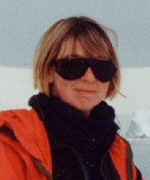
Dr. Elizabeth Morris
Scott Polar Research Institute
Cambridge, United Kingdom
View Biography »
Presented at 5:00 pm, Tuesday Evening, December 4, 2012
Moscone South – Room 103
“Hot ice and wondrous strange snow”: three-phase mixtures or something more?
Watch Online
Abstract
Over the 40 years since John Nye and his colleagues studied regulation and the thermodynamics of water inclusions in polycrystalline ice, physics-based models of mixtures of ice, water, and water vapor have become widely-used in glaciology. Such models have been developed, for example, to predict snowmelt and avalanches, to understand the movement of impurities in snow and ice cores, to estimate densification at the surface of polar ice sheets and to help interpret satellite data. The basis for mixture theory models is the concept that each volume of the mixture contains an abundance of all the constituents dispersed within it. In other words, the model equations describe properties averaged over a scale which is many times larger than the size of each constituent – the grain size in snow, the inclusion size in temperate ice and so on. All thermo-mechanical models developed so far make simplifying assumptions, sometimes simply to limit the time required for computation, as for example in the snow models used in climate models, but also because all the necessary constitutive relations required for a full thermo-mechanical treatment are not available. Deriving suitable constitutive laws for such a complex, sensitive material has vexed experimentalists and challenged the most determined of mathematical physicists. Nevertheless, progress has been made. New measurement techniques, for example, the non-destructive measurement of snow density using neutron-scattering and the determination of glacier ice water content using radar, provide better validation data, which can expose weaknesses in the model equations. In the future, we can hope that scaling-up from models of processes on the microstructure scale will provide a solid theoretical foundation for new mixture-scale constitutive relations. For many glaciological problems, the mixture-theory approach is the only practical option. The challenge is to ensure that the complex behavior of the material is well-represented and essential detail is not lost by averaging on the mixture scale.